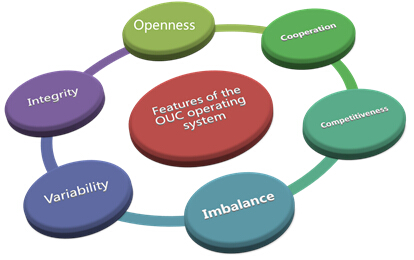Page 4 of 6
3. The features of self-organization construction of the OUC operating systemBased on methods such as self-organization conditions, synergy drive, evolutionary path, super-circulatory combination, fractal structure, chaotic evolution and generalized self-organization, and relying upon the background of the OUC construction, compositional structure, school management concept, function orientation, and historic mission, it has been decided that the construction of the OUC operating system should have the following features (see Figure 4).
3.1 Integrity
The OUC headquarters, branches, local colleges and learning centers, as well as the enterprise and industry colleges, are all integral parts of the OUC. Each of them plays their own part, coming together to form a multi-dimensional operating system covering all urban and rural areas of China, they shoulder the important task of building a learning society. The integrity of the OUC operating system also indicates its function serving social and public welfare.
3.2 Dynamic openness
As a dynamic and open system, the OUC operating system prioritizes openness across all aspects, including educational concept, operating mechanism, training and management methods, educational resources, and exchanges with the outside world in terms of materials, information, resources and personnels. As far as the construction of the operating system is concerned, the OUC should not only endeavor to give full play to the experience accumulated by the RTVU system over the past thirty years , it should also open channels and absorb new forces to show the OUC’s core value of operating the university within society. It is not an unchanging system,but one that makes dynamic adjustments according to internal and external conditions and current tasks of operating system construction, including the mechanisms of cost sharing, resource sharing, interest distribution, and access and withdrawal.
3.3 Cooperation
All the members of the OUC operating system work together to minimize “internal friction”, reduce “negative energy”, and amplify “positive energy”, by the way of clear division of labour, coordinated reform, collaborative exploration, in-depth participation, brain-storming and general consensus. This helps solve the problems arising during the construction of the system and reduce the costs of running the school, thereby increasing educational efficiency and social benefit. To this end, the OUC supports all provincial RTVUs in advancing the construction of open universities in accordance with national and local education development plans,and to rename themselves as local open universities in a timely fashion. At the same time, the OUC supports the establishment of regional branch cooperation and coordination mechanisms and their service to local economic and social development.
3.4 Competitiveness
Competition in the form of development demands, resources and information exchange inevitably arises between the many departments and actors within the OUC operating system. However, only when proper competition is allowed and encouraged can the operating system be urged to carry out cooperation and synergetic innovation at a higher level and a larger scale, in order to activate its overall strength and form a school network with great influence and interaction.
3.5 Imbalance
Due to a number of factors such as economic and social development, historical status, and different self-development strategies, a substantial gap exists between some members of the RTVU system, highlighted by imbalanced resources and management standard and scale. The 44 provincial RTVUs are on different steps of the development ladder and the RTVUs at the grass-roots level also differ greatly in scale,management strength,development model and social influence.
3.6 Variability
The construction of the OUC operating system is a long and complex process. During this process, all parts of the system will transition from a stable RTVU system to a stable OUC system. All the constituent parts of the system will undergo constant changes, and once the various controllable and uncontrollable factors reach a critical level, there will naturally be mutation and variation. As a result, some new stabilities may appear.

Figure 4 Features of the OUC operating system